PNSO delivered one last surprise for collectors at the very end of 2022, delivering their 67th entry into the Prehistoric Animal lineup with a highly anticipated, superb new rendition of the most complete spinosaurid to date.
The 1990s and 2000s were a boon for paleontology in the southern hemisphere. New discoveries from South America, China, and Africa were shaking up the paleosphere, reinvigorating awareness and understanding of dinosaurs, old genera and new. One of the notable new discoveries was Suchomimus tenerensis (crocodile mimic of the Ténéré Desert), a large Cretaceous theropod uncovered from the Elrhaz Formation in Niger, Africa. Officially described by Paul Sereno and his team in 1998, Suchomimus helped unite certain enigmatic and peculiar theropods like Spinosaurus and Baryonyx into the single clade of Spinosauridae. As the most complete representative of the spinosaurs to date, Suchomimus also gave scientists further insight into the possible appearance of Spinosaurus itself, just in time for the sail-backed giant to get nominated for Jurassic Park III as the film’s starring villain. Suchomimus itself would get acknowledged briefly in the film (alongside Baryonyx) while the protagonists attempt to classify their new nemesis.

Despite its paleontological significance, Suchomimus hasn’t quite made it to A-rank dinosaur stardom; but it still frequently makes appearances in dinosaur media, and has several toys to its name. However, with the last figure of particular note (at least, the last not connected to the Jurassic World franchise) having been released almost a decade ago now, a more up-to-date mainstream figure was highly in demand within certain collector circles. Thankfully, as an end-of-year surprise, the prolific Chinese company PNSO stepped up to the plate and introduced the Nigerian crocodile mimic as the newest member of the Prehistoric Animal Models line, capping off 2022 and paving the road into the new year for dinosaur fans.
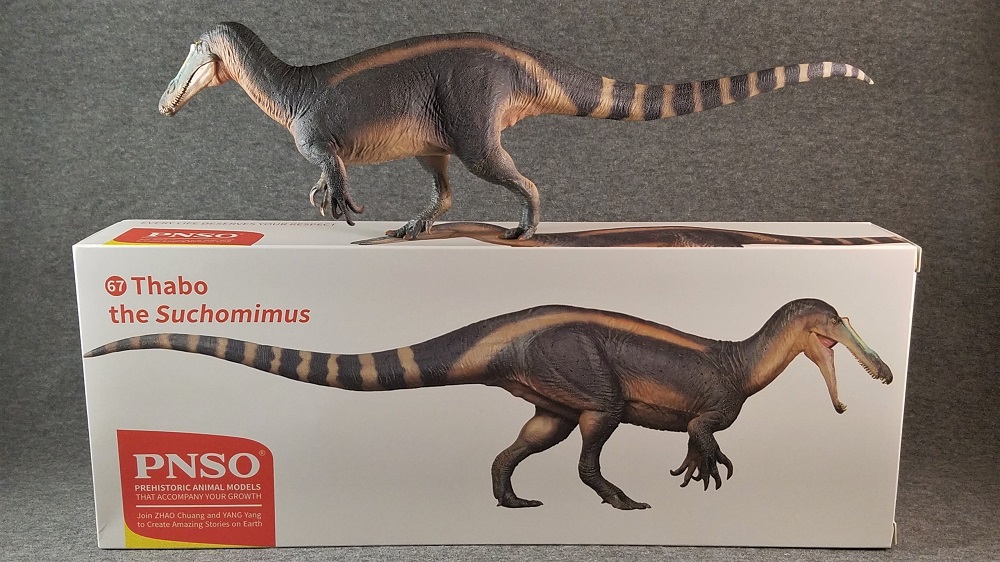
Thabo the Suchomimus is the 67th large-scale prehistoric animal released by PNSO (both numerically and chronologically – PNSO often releases their figures out of numerical order, but Thabo is both the highest-numbered and most recent release in the line). Like all of PNSO’s releases, the model is packaged securely in a white box decorated with crisp photos and typical informational product text, with a booklet and poster included inside for education and reference. A small, clear plastic stand is also packaged inside, as is standard for PNSO’s theropod models, as a precaution in case the model needs extra support. Thankfully, my model balances very well on its own so far. The jaw is articulated – again the standard for PNSO theropods – and functions quite nicely; although the teeth are small enough that mild caution is warranted, so as not to bend or break anything by accident when handling the jaw.
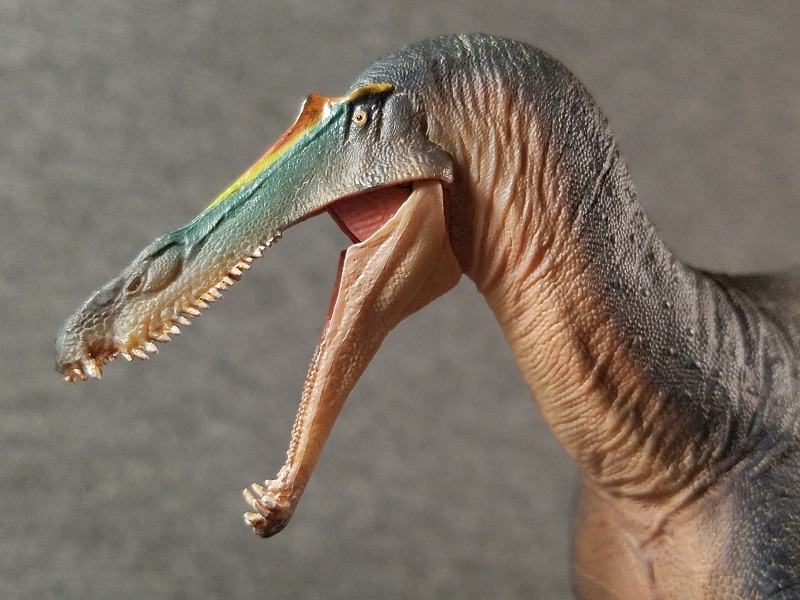
Measuring 29 cm (11.5 in) long from nose to tail (not accounting for curvature along the spine), this Suchomimus model fits within the range of 1:32-1:38 scale, depending on the life-size estimate of choice (9.5-11m). I did some additional rough measurements of the skull and hind limb specifically, and their proportions also match this scale range, falling closest to 1:34 or 1:35. Great attention to detail has clearly been applied to this model, carefully reflecting current skeletal reconstructions of the animal. The most obvious characteristic is the skull, which looks shockingly narrow in portrait but accurately reflects how slender the known skull materials really are. If anything, when viewed in profile the jugal (cheek) area of bone almost looks a little too deep; the fossils seem to indicate a more level surface to the length of the mouth. Paul Sereno might have been better off naming this dinosaur “gharial mimic” given its bizarre dimensions.
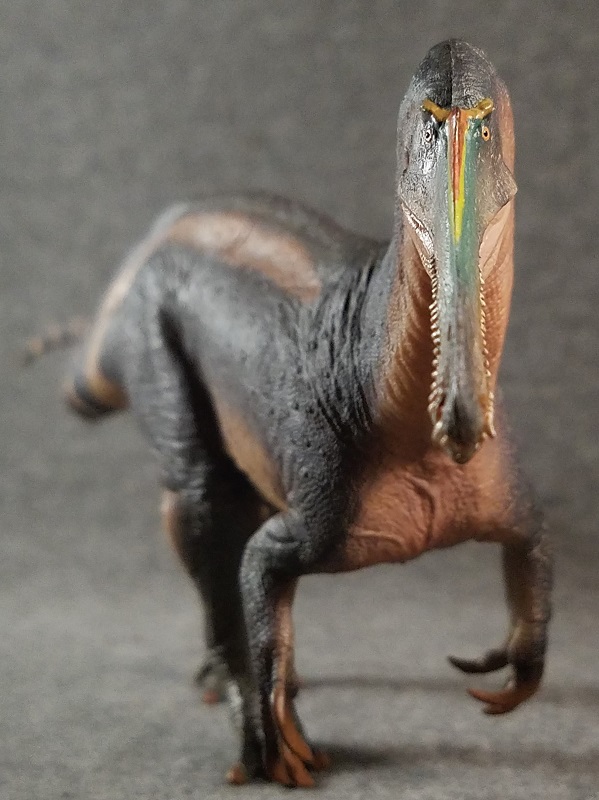
The postcranial skeleton of Suchomimus was a little more standard for theropod body types, with muscular limbs, longer legs, and a robust torso. The PNSO model depicts a healthy specimen with a deep belly and plump ribcage. The legs are shorter than those seen in abelisaurs or tyrannosaurs, resulting in the body hanging low enough for the large arms to nearly reach the ground (although the model also is posed leaning over somewhat, which exaggerates this appearance a bit). The fingers and claws are of appropriate length, with the third digit as the longest and the thumb as the shortest. The thumb, of course, compensates for length by wielding the massive claw which was the claim to fame for Suchomimus’s European relative Baryonyx. Many Tetanuran groups – allosaurs, megalosaurs, etc. – featured this signature “killing thumb”; but the spinosaurids were perhaps the most dramatic example of this feature, at least until the rise of the megaraptorans.
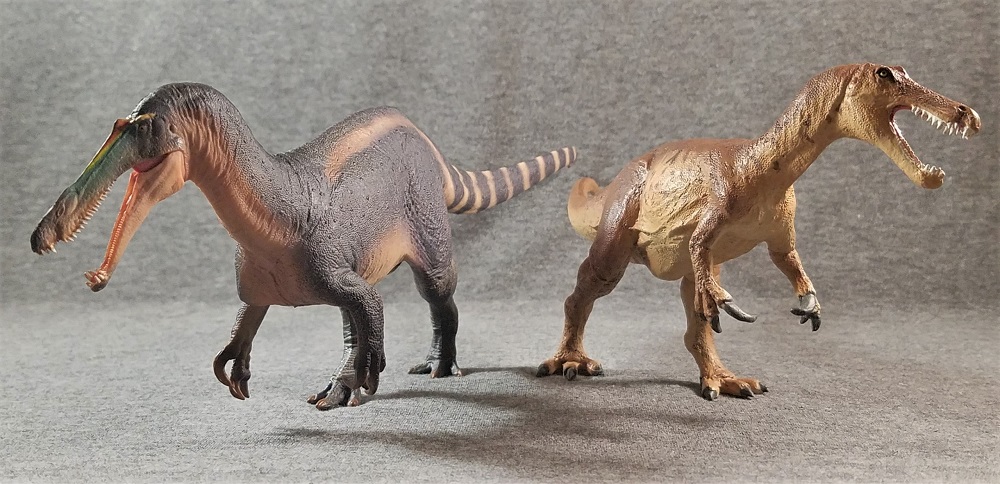
The other famous physical feature of spinosaurids, the sail, was far less developed in Suchomimus; however the genus still displayed neural spines over its back which were taller than usual for theropods. Looking at Thabo, it’s possible PNSO may have actually understated the neural spines for this model. Admittedly, it’s harder to tell with the added layers of soft tissue, but I believe the dorsal ridge over the hips could at least be slightly larger. The model is posed in a slow gait, standing stable on two feet, which are known from good fossils and were more typical in shape than the flat toes more recently uncovered for Spinosaurus itself. As a possible nod to the larger theropod, however, PNSO opted to depict the hallux (the small innermost toe) of Suchomimus a little more prominently than usual, long enough to nearly touch the ground. The tail displays thick caudofemoral muscles at the base, but becomes quite narrow in the latter half, reminiscent of a monitor lizard. A flattened tail can be a useful swimming tool for an animal living around water frequently, although it’s still debatable how aquatic in lifestyle Suchomimus really was.
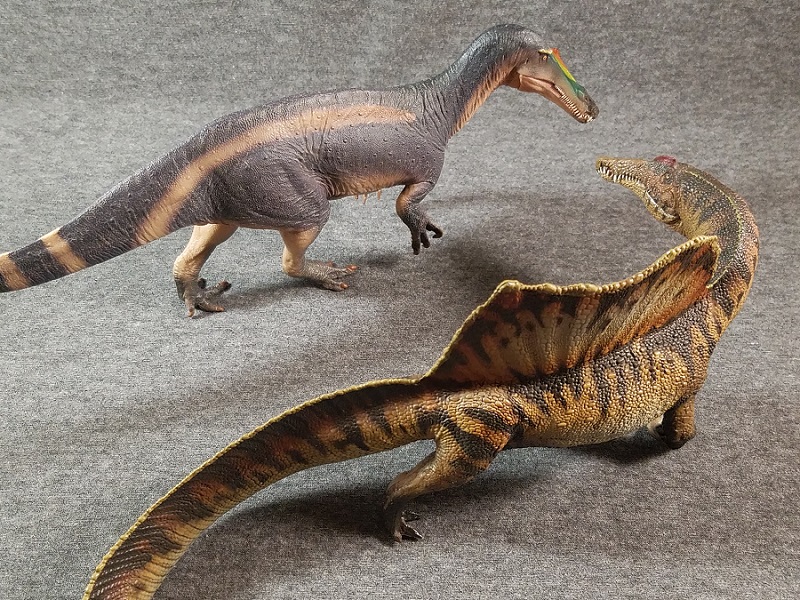
PNSO prides itself in dedication to scientific accuracy; but where their models perhaps excel the most is in lifelike fine details, and Thabo the Suchomimus is a prime example of this excellence. Suchomimus is sculpted with a full coating of scales, nose to toes, with rigorous attention to shifts in shape and fit of the skin over the musculature across different body regions. No skin impressions are known for spinosaurids, but the application on this model looks incredibly lifelike and plausible enough for the creature. Most of the body is covered in tiny adjacent circular scales, whereas the arms bear larger, rectangular scales on the external sides (reminiscent of crocodiles or large lizards). The face, in contrast, bears such minute scales that its surface appears almost smooth. Speculative rows of larger round scales – possibly feature scales or osteoderms, like those recorded from samples of the abelisaur Carnotaurus – run from halfway down the neck to the first third of the tail, dotting the flanks and thighs along their way. Heavy wrinkles and stretch marks around the neck, hips, and along the stomach convey the sense of a living, active creature. Fine definition of the prominent muscles down the body, tail, and limbs further accentuate the model’s illusion of organic weight and movement. A patagium membrane in front of the legs and a modest cloaca just behind the ischium bone are among the finishing details to what looks like a real-life predatory dinosaur captured in miniature.
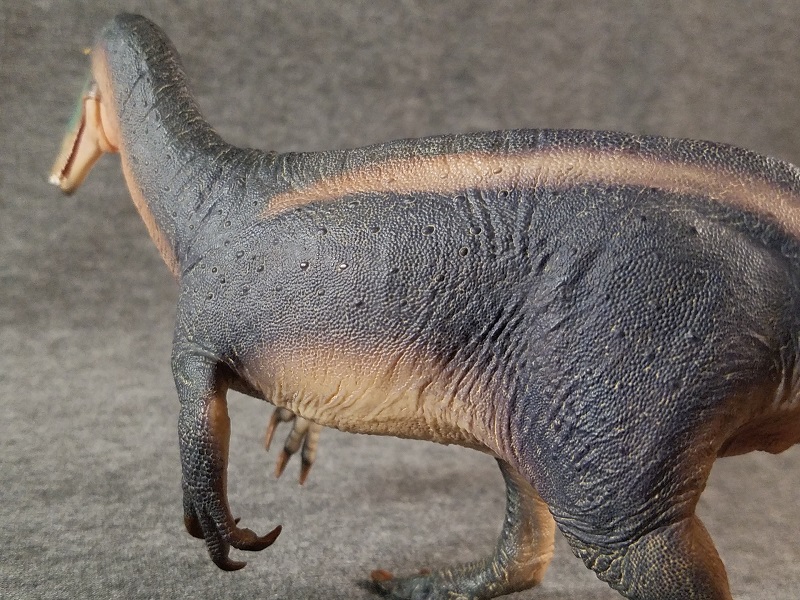
Coloration on Suchomimus is simplistic in scheme, but expertly applied. The base skin color is a pinkish orange, with charcoal gray layered on top over most of the body. The belly remains orange, and striping along the body and tail in opposing patterns breaks up the silhouette of the figure. The underlying orange also gives each and every scale definition through the grey coat, and the contrast in light and dark hues makes for a striking appearance even with the conservative color choices. To spice up the coloration a little more, however, the crest and bridge of the snout is highlighted with stripes of saturated green and yellow, topped off with more bright orange which matches the color of the carefully rounded eyes. It’s not hard to imagine this splash of facial color being used for infraspecific communication, like the bright colors on the faces of some birds today. The teeth are painted white with remarkable cleanness for their diminutive size, and the mouth is a gentle pink. The hand and foot claws are also distinguished with a gradient of polished brown.
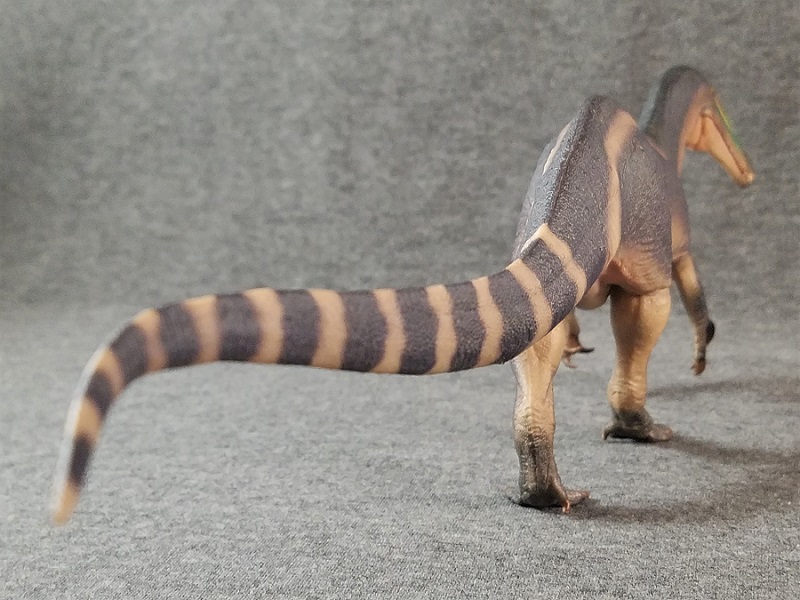
Although 2022 was a relatively smaller year for PNSO, compared to their abundant releases from 2021 and 2020, collectors were nonetheless blessed with multiple new figures featuring some highly desired genera treated with the high quality collectors have come to anticipate from the company. Thabo the Suchomimus was a wholly unexpected, but very welcome cap to the year’s releases. Even following some strong contenders, Thabo deserves to be considered one of PNSO’s finest theropods to date – nay, this is one of the best spinosaurid models available across the entire market. PNSO currently sells Thabo through their Amazon and AliExpress pages, and retailers like Dan’s Dinosaurs and Everything Dinosaur also sell the figure or will be stocking it soon. Whichever retailer you prefer, rest assured this is a worthy addition for your collection. Thabo the Suchomimus gets my highest recommendation!
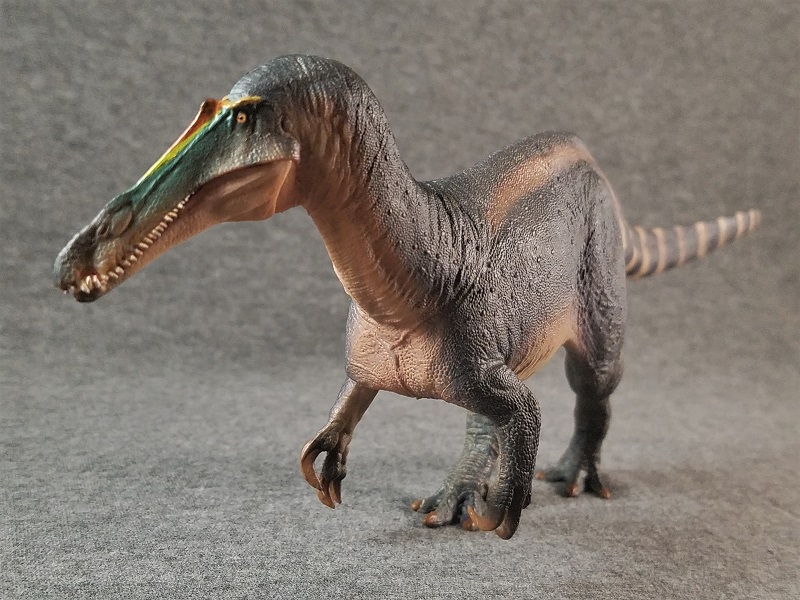
Disclaimer: links to Ebay and Amazon on the DinoToyBlog are affiliate links, so we make a small commission if you use them. Thanks for supporting us!





Beautiful model. I’m a little disappointed with the lack of a more pronounced ridge along the back, though.
Love the review, love the model. Thanks!
One of the best from PNSO this year, and one that I definitely have to get.
@Fembrogon Nice model! Certainly not as controversial as the similar 'Sinopliosaurus'!
Remote Reply
Original Comment URL
Your Profile